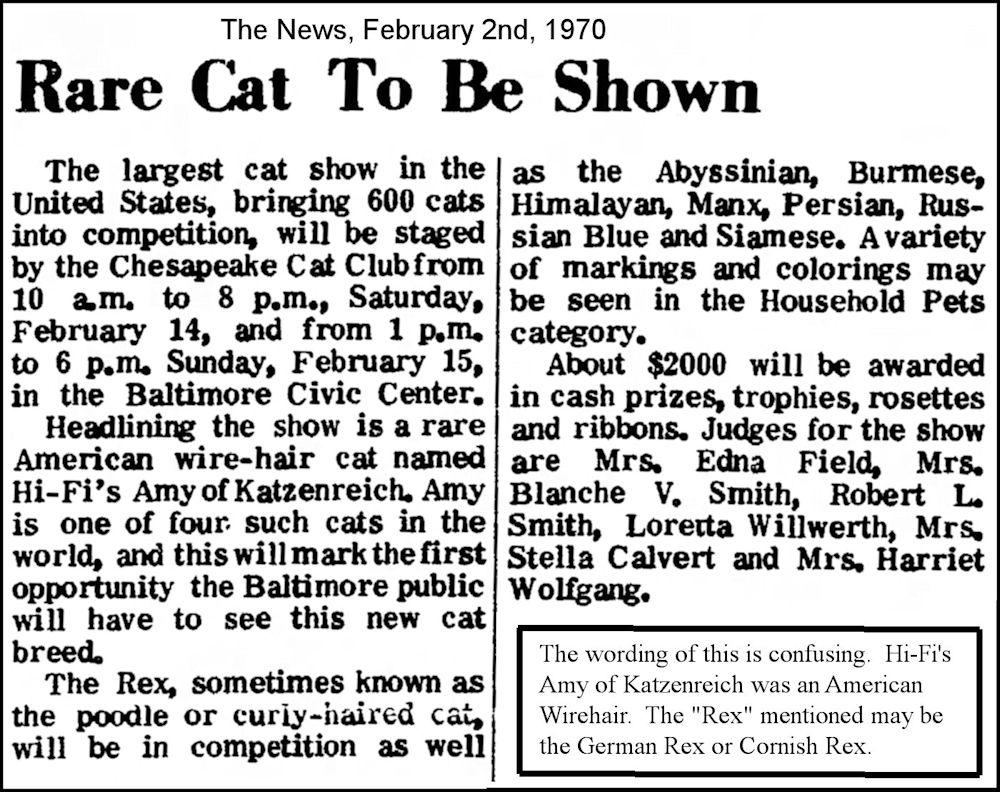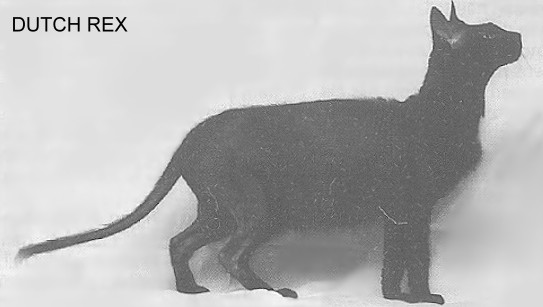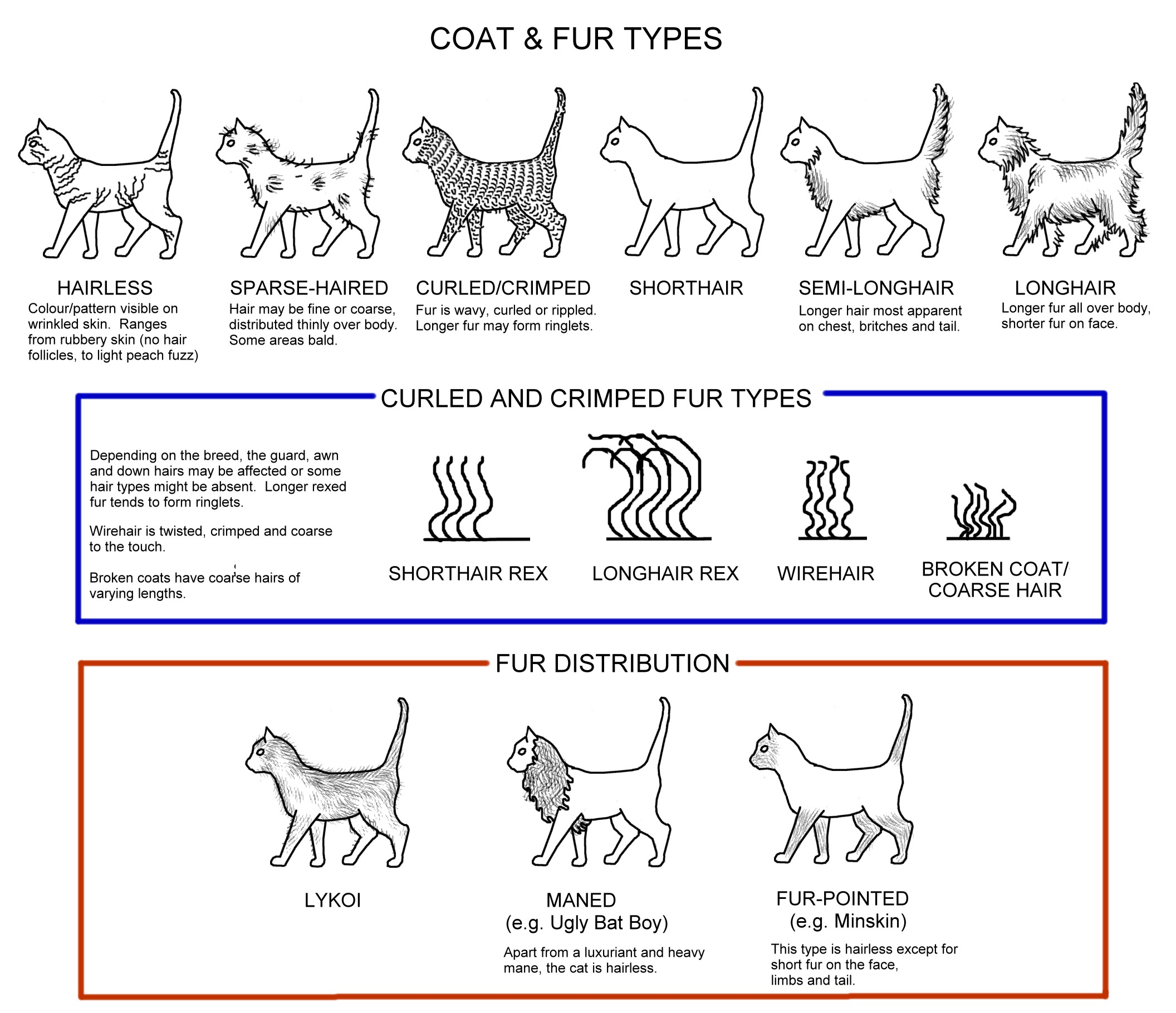
WIREHAIR CATS
The origins of the major wirehair breeds are well documented elsewhere so I have included a summary only. I have included all relevant information without prejudice. Other opinions are mine alone.
WIREHAIR AND BROKEN-COATED CATS
In "The Book of the Cat" (1903), Frances Simpson quoted H C Brooke "A cat called the Mombassa cat, from the East of Africa, is said to have a short coat of wiry texture." This sounds like a Rex or wirehair cat and is also reported by Helen Winslow in "Concerning Cats". In "Variation of Animals and Plants Under Domestication" Charles Darwin had written: "On the opposite coast of Africa, at Mombas, Captain Owen, R.N. states that all the cats are covered with short stiff hair instead of fur".

The American Wirehair was discovered in Vernon, New York, America in 1966. The founding father was Adam, a red-and-white kitten born to two farm cats. Adam's coat was dense, harsh and springy. Adam's siblings were killed by a weasel. He was obtained by German Rex breeder Joan O'Shea for $50. Her friend had remarked that a cat similar to her Rexes had been born and although the farmer was initially unwilling to part with Adam, Joan O'Shea persuaded him of the cat's importance. With no female Wirehairs to breed him to, and unable to breed him back to his mother, Adam was allowed to breed with the domestic cat next door, resulting in a litter of wire-haired kittens and no doubt as to their paternity! His daughter, Hi-Fi's Amy of Katzenreich, went to Bill and Madeline Beck who had experience in breeding Rexes. The American Wirehair breed was recognised in 1977. Unlike the Cornish, German and Devon, the wirehair is due to a dominant gene and therefore does not always breed true. The fur is crinkled and coarse, with hooked or bent hairs, like that of a Fox Terrier dog and this breed does not seem to have attracted the same popularity as the Cornish and Devon Rexes and has grown slowly. The rise of the native American Wirehair may have led to the decline of the imported German Rex breed in the USA.

A Dutch Rex mutation appeared in the Netherlands 1969 but vanished. It was a dominant gene mutation and the hair tended to form dreadlocks. It was prone to balding in places and the hair tended to become coarse as the cat matured. It was reported that the cats lost their curly fur if they bore offspring. Another Dutch Rex mutation, or reapperance of the original one, was reported in 1985. This had a coarse wavy coat with a brittle texture and has also been called the Wirehair Rex. The Dutch Rex (Wirehair Rex) reappeared in 1985 and has a bristly, wavy coat with a brittle texture. It was reported in Dutch cat fancier magazines but little has been heard about this variety in recent times.
In 2003, some "Wirehair Rexes" were born in Brooklyn, USA, but unfortunately died, apparently from cold (heating pads for winter-born kittens have prevented a repeat of this). After the first few weeks, Wooleys seem to be hardy. The sire, Wooley, was a cat with wiry rex coat, curly guard hairs and hardly any undercoat. The mating was repeated. Wooleys mother (the foundation cat) had 2 bald kittens with curly whiskers, born before Wooley, that did not survive. The effect of the Brooklyn Rex mutation is a rippled coat with all hair types and bald kittens which grew coats. By 2006, there were a total of 9 Wooleys. They are low-shedding on a day-to-day basis, but periodically moult the hair on the belly and inside the legs, creating bald spots that an unwary observer might mistake for a skin disease. The hair regrows as wavy as before. The most recent 2 Wooleys were born bald on the belly and have 2 normal-haired siblings. Straight-haired cats with coarse coats go on to have wavy fur. Colourpoint Wooleys are blue-eyed. Initially the Ojos Azules gene was suspected due to the flattened tail-tip and wide-spaced eyes. The Brooklyn Rex mutation is being developed under the breed name of Wooley (originally Brooklyn Wooley) and initially thought to be identical to the Texas Rex mutation or to the short-haired LaPerm. Breeding over the next few years established it to be a different mutation. It isn't known if the gene is dominant or recessive because all of the Wooleys are descended from related cats. So far, outcrosses have not produced any Wooleys. However, even in matings between a wooley and a related cat there might be no Wooleys or a mix of curly-haired and straight-haired kittens! The hair type can also change: kittens with straight, coarse hair later turn wooley while born-curly wooleys turn straight and then curl up again periodically for a few months and then remain curly. Wooleys are very outgoing and affectionate cats and really love to greet people and cuddle.
|
|
|
|
Scrappy Wooley (Photos copyright Sandy Sweet. )
| |
|
|
|
|
|
Bramble images copyright Gary Bramlett |
||
Another wire-coated breed (announced 2006/7) is the Bramble, bred by Gary Bramlett using Bengals, brush-coated Peterbalds and other unspecified breeds. Its non-shedding wire coat resembles that of a wire-haired Fox Terrier dog. It is a large, muscular cat accepted in any pattern and colour although the rosetted pattern inherited from the Bengal is most popular. The Bramble is a non-aggressive, people-oriented cat with a strong personality. It is fearless, intelligent and has the love of water from its Bengal ancestry. The Peterbald's "brush coat" was originally reported in heterozygous cats (cats with one copy of the Peterbald hairlessness gene) which means it would not breed true. Offspring from Bramble-to-Bramble matings that inherit 2 copies of the gene (are homozygous) might be expected to be hairless or lose their brush coat as they mature. According to Gary Bramlett, not all Peterbald lines lose coat in this way and the gene expression results in Ultra-hairless (very bald, almost sticky skin), Chamois (hair not visible, but can be felt), Suede and Brush. Brush ranges from short, soft hair that doesn't lie flat, longer poodle-like fur to harsh-wiry fur and may be soft (undercoat only), sparse or thick. Polygenes may be involved. To accommodate the variability, the Bramble standard permits hairless and straight-coated cats; the hairless variants will not be bred from.
WIREHAIR FUR
In brief, a cat has three main types of fur: long guard hairs, shorter awn (bristle) hairs and woolly down hairs. The guard and awn hairs form the top-coat and the down hairs form the undercoat. In addition, specialised hairs form the whiskers. Wirehair cats have all three types of hair, but all are rough, crooked and unruly. As more and more rexoid cats are reported, a wider variety of fur modifications are being described. One of the more unusual modifications was a cat reported in 2003 that had long whiskery guard hairs, but lacked down and awn hairs, and was otherwise bald.
